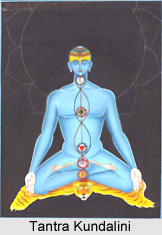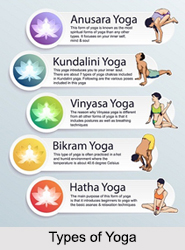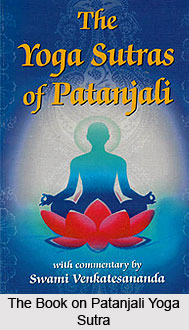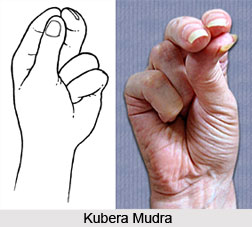 Dharana, the premier level of concentration, is known as the sixth stage or limb of the total eight stages of Patanjali`s Ashtanga Yoga or Raja Yoga. The concept of Dharana can be said to be the collection or concentration of the mind (merged with the withholding of breath), or `the act of holding, bearing, supporting, maintaining, retaining, keeping back, a good memory`. This term `dharana` is derived from the verbal root `dhri` meaning to hold, carry, maintain and resolve. Modern sciences like clairvoyance, clairaudience, mesmerism, hypnotism; thought reading, music, mathematics and others depend upon the concept of Dharana.
Dharana, the premier level of concentration, is known as the sixth stage or limb of the total eight stages of Patanjali`s Ashtanga Yoga or Raja Yoga. The concept of Dharana can be said to be the collection or concentration of the mind (merged with the withholding of breath), or `the act of holding, bearing, supporting, maintaining, retaining, keeping back, a good memory`. This term `dharana` is derived from the verbal root `dhri` meaning to hold, carry, maintain and resolve. Modern sciences like clairvoyance, clairaudience, mesmerism, hypnotism; thought reading, music, mathematics and others depend upon the concept of Dharana.
While practicing Dharana, the sadhaka holds steady his mind, in terms of concentration or single focus. The prior limb Pratyahara involves withdrawing the senses from external phenomena; whereas Dharana builds up further concentration upon this by refining it further to the state of `ekagrata` or `ekagra chitta`. `Ekagrata` refers to single-pointed concentration and focus, which is similar to the idea of `shamata`. Thus, Dharana simply depicts the state when the mind thinks about one object and avoids other thoughts.
Dharana is the preliminary step of deep concentrative meditation, where the object being focused upon is strongly held in the mind without the consciousness shrugging away from it. There is a subtle difference between Dharana, Dhyana, and Samadhi (the three combined elements of Samyama). In the former, the object of meditation, the meditator, and the act of meditation itself remain separate, that means, the meditator or the meditator`s meta-awareness is conscious of meditating on an object, and of his or her own self, which is concentrating on the object. In the following stage of Dharana, as the meditator reaches a higher state, consciousness of the act of meditation almost disappears, and only the consciousness that exists in the mind is the object of concentration.
Working with complete focus and concentration is something that satisfies every individual. An individual is bound to feel a sense of frustration, when he/she is not able to focus. The inability to focus may be because the minds are always racing with ideas, judgments, worries, songs, or even memories. The core idea in Dharana is the ability to focus on something (uninterrupted both by external or internal distractions). This form of meditation can be called `receptive concentration` and a set of conditions are created that helps the mind to focus in one direction and object, rather than concentrating in diverse directions and divert the mind. The term `Dharana` is applicable for both states of deep concentration and the state in which the person achieves deep concentration. Ideally, `Dharana` can be performed in any time of the day to gain utmost control of both body and mind.
Dharana aims at setting up the mind by focusing it upon some stable entity. One good method to start the process of Dharana is by rolling the eyes upward and downward, in one direction to attain the concentration. Any object selected for practicing has no real function to play in the meditation process. The object is only used to stop the mind from wandering through dreams, memories, or reflective thought, by intentionally holding it fixatedly upon some motionless object. This ability is a movement towards the perception of its true nature and not an escape from reality. Dharana also helps in channelising one`s thoughts on a particular thing. After following certain steps of Dharana, the person reaches a level of awareness, where he/she takes every step after much insight and consideration. Dharana can bring richness to one`s life with the help of deep contemplation and reflection. Dharana works with the aim to achieve the mental state, where the mind, intellect, and ego are controlled; and the person can thus take the right decisions in life. The mind becomes purified by the practices of Dharana. Dharana also helps to control the fluctuations in the mind to a great extent.
Practicing Dharana at the time when the person is struggling with anger, restlessness or expectation would help to balance those excessive emotions. Dharana is the practice of training the mind, in such a way, that the practitioner can possibly avoid frustrations. Concentrating the attention on one point makes the mind to be stable and calms the disturbance of activity, to which normal mind is used to. The point of concentration can be anywhere within the body or outside. Therefore, maintaining a fixed and focused concentration, throughout the practice, gives consistency and clarity to the thoughts.
Dharana belongs to the `higher stages` of yoga sadhana - the realm known as Samyama Yoga. This kind of Yoga encompasses the inner practices of Dharana (concentration), Dhyana (meditation) and Samadhi (mystic absorption). According to modern psychology, the mind cannot stay fixated on any solitary object for any considerable period. Rather, it is bound to move in some possible way, although the boundaries of that movement can be controlled. The more skilled an individual becomes in this `restriction of the mental field` - the more expert the person becomes at completing particular tasks. However, according to Eastern psychology, although concentration begins with this form of `controlled` or `contained` movement of the mind, it is also possible to attain a higher state wherein all mental movement ceases. Gradually, the mind `becomes one` with the essential nature of the object of concentration, and therefore it can move no further. Thus the general idea of Dharana evolved as the state that depicts lack of movement (completely stopping the mind), yet with awareness (illumination), that the mind must first achieve in order to be able to make the `jump` from one plane of consciousness to the other.
Concentration is like a muscle and its ability increases with practice and also diminishes with disuse. Thus, it is important to perform customary physical exercises to keep the body strong and fit; exercising the mind is also important to keep it still and focused.
The practise of Dharana include the following ways -
•One should fix the mind on some object either within the body or outside and keep it there steady for some time. Dharana have to practise this daily. Laya-Yoga has its basis on Dharana.
•The practitioner should purify the mind first through Yama, Niyama and then reach to the practice of Dharana. Concentration without purity is never fruitful.
•If the practitioner has practised Asana and has purified the Yoga Nadis, he will be able to concentrate easily. Concentration will be intense if he/she removes all distractions. A true Brahmachari, who has preserved his Veerya, will attain blissful concentration.
•One can concentrate internally on any one of the seven Chakras and externally on any Devata, Hari, Krishna or Devi.
•Attention plays a prominent role in attaining Dharana. He who has developed his power of attention will gain peaceful concentration in a much shorter period.
•If the sadhaka has gained Pratyahara (withdrawing the senses from the objects), he will find the path to Dharana faster. He/she has to lay the foundation of Yama, Niyama, Asana, Pranayama and Pratyahara to reach to Dharana. The super-structure of Dharana and Dhyana will only then be successful.
•The Yogi should be able to visualise very clearly the object of concentration even in its absence. He/she must be able to recall the mental picture at a moment`s notice.
•Initially, the practitioner can start to concentrate on the `tick-tick` sound of a watch or on the flame of the candle or on any other object that is pleasing to the mind. This is called the `concrete concentration`. Gradually, the sadhaka will not even require any material to set his/her concentration.
•If the person wants to increase the power of concentration he/she will have to reduce the worldly activities and will have to observe `Mouna` (verbal silence) everyday for two hours or even more.
•Vedantics try to fix the mind on `Atman`. This is their way of attaining Dharana. Bhaktas concentrate on their Ishta Devata. Hatha Yogins and Raja Yogins concentrate their mind on the six Chakras. Other objects of meditation are described under Trataka and Laya Yoga. Concentration is necessary for all kinds of aspirants.
One of the greatest achievements of Dharana is `Insight`. If the sadhaka reads Bhagavad Gita or any other philosophical text with concentration, he/she can obtain new ideas each time. Through concentration, the person will develop the power of insight. Subtle mysterious meanings will flash out in the field of mental consciousness and the person will understand the inner depth of philosophical connotation. The Yogi may often experience a disturbance of emotions; however, they will pass away soon.
For a beginner, the practice of Dharana is tiring in the beginning. He has to cut new grooves in the mind and brain. After two or three months, he/she enjoys a new kind of happiness and soon realises that concentration is the only way to get rid of the miseries and tribulations. When desires arise in the mind, it is best to reject them as soon as they arise. By gradual practice the desires can be reduced and the modifications of the mind will also diminish. The person must get rid of all sorts of mental weakness, superstitions, falsehood and illogical Samskaras. Dharana is associated with the practice of Japa (continuous recitation) of `Om`. While studying Ashtanga Yoga, it is seen that Dhyana as a process comes later in the study; Dharana comes before Dhyana process.
To stabilise the mind while in Dharana, attention has to be paid as to how the external perceptions can be reduced. The surroundings should be pleasurable to the mind and not troublesome. The place should be devoid of any external disturbances. The general chaos, other sounds, strong breeze, different smells, extremely bright light are various disturbances that should be avoided while Dharana. Then one should sit on a comfortable seat in a pose conducive to Dhyana such as `Padmasan`, `Swatikasan` or `Siddhasan`. One should have the habit of sitting firmly, yet comfortably in a particular pose for a long duration. Otherwise, the mind can get diverted towards the gestures from various muscles.
The pose of sitting should be "samkay shirogreevam" and the eyes should be fixed on the image of `Om` in the front. The picture should be at the eye level and placed under ample light. Whenever the eyes try to turn away from the picture, an effort should be made to lock it on the picture again. The mind generally follows the eyesight, so fixing of the gaze will result in locking the mind too. The sound of `Om` coming through the mouth should be gradual and effective. The vocal cords or the lungs should not feel strained while doing the Japa. As the tongue is engaged in the japa of `Om`, the mind will eventually follow the tongue and will restrict its movement towards `Om`. The japa is automatically heard by the ears and felt by the mind. Thus, the mind will be firmly kept onto the utterance of `Om`.
Out of five sensory organs, the eyes, the tongue and the ears are concentrating on only one subject of `Om`, here, Om is an "alamban" and the dimension covered by `Om` is the restricted area in which the mind can move (deshbandh). After some time, the japa should be stopped and one should close the eyes and try to concentrate the mind on the memories of `Om` sensed through the gaze, the tongue and the ears. This experience enlivens the sensory organs and the mind gets engaged into the realm of real dharana. With further practice, the area of the "alamban" or its limits can be reduced even more. With the reduction of the area, the dharana will become more effective and the sadhaka will get nearer to the next stage of dhyana.
Thus, Dharana benefits the sadhaka in several ways; it reduces the occupied mind. Hence, the disadvantages of such occupied mind also get reduced and the mind is kept firm at one place that reduces the entrance of anything evil or destructive. The mental strength of the individual increases and work is done effectively and efficiently.




















